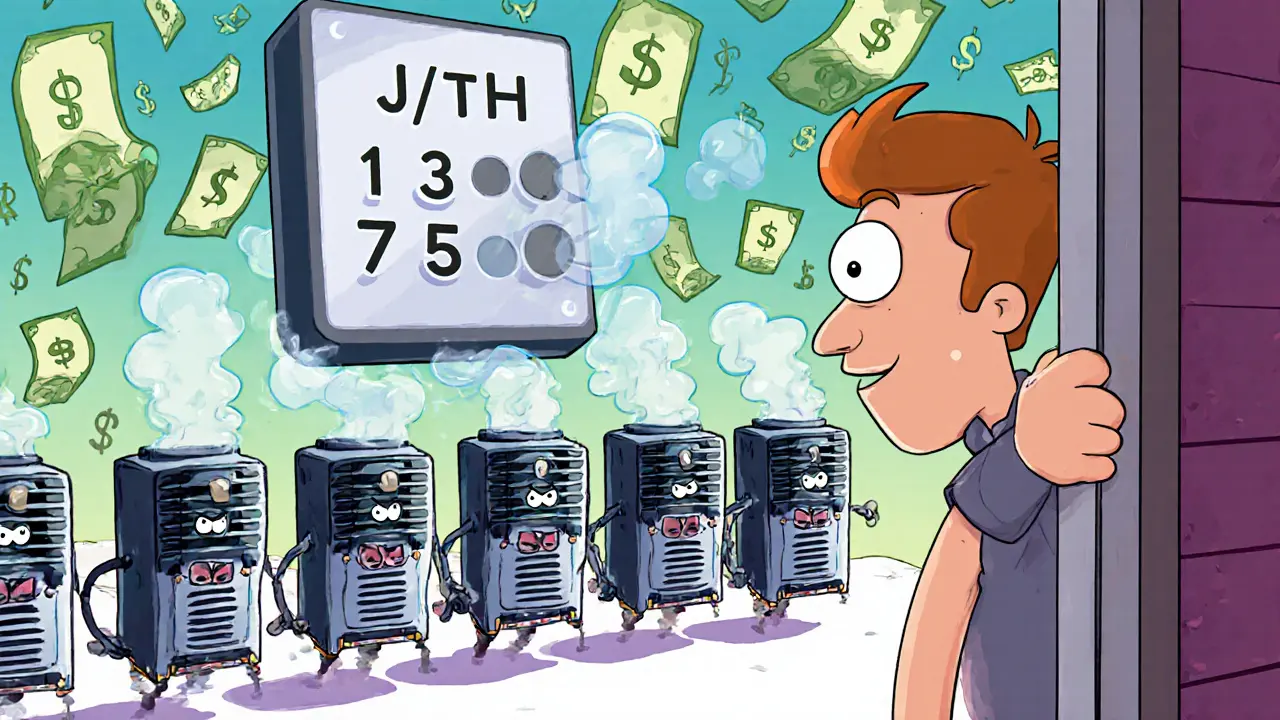Bitcoin Mining Profitability Calculator
Mining Hardware Profitability Calculator
Estimated Daily Profit
$0.00
Based on current Bitcoin price and network difficulty
J/TH Efficiency: 10.0 J/TH
Power Draw: 10,000W
Hashrate: 1,000 TH/s
Important Note: Actual mining may vary based on network difficulty and Bitcoin price.
When you hear someone say Bitcoin mining uses more power than a country, it’s not a myth - it’s mining hardware power consumption in action. In 2024, Bitcoin mining alone used 162 terawatt-hours (TWh) of electricity. That’s more than Poland. And it’s not just Bitcoin - every crypto that uses proof-of-work mining, from Ethereum Classic to Dogecoin, runs on machines that guzzle electricity like a desert town on a summer night.
But here’s the real question: if you’re thinking about mining, or even just curious why your neighbor’s garage smells like a server farm, how much power does the actual hardware use? And more importantly - does it make financial sense?
From CPU to ASIC: The Power Evolution
In 2009, when Bitcoin was born, you could mine it with a regular laptop. A single CPU pulled around 80 watts and churned out maybe 5 megahashes per second. Back then, electricity cost was barely a thought. You mined for fun, not profit.
By 2013, GPUs took over. A single high-end graphics card could pull 250 watts and deliver 500 MH/s. Mining became a hobbyist’s side hustle. But then came ASICs - chips built for one thing: mining Bitcoin. These machines didn’t just improve efficiency - they rewrote the rules.
Today’s top ASIC, the Bitmain Antminer S21e XP Hyd 3U, uses 11,180 watts. That’s more than a home air conditioner. But here’s the twist: it does 860 terahashes per second (TH/s). That’s 10,000 times more work than a 2009 laptop, using only 140 times more power. Efficiency isn’t just nice - it’s survival.
How Power Consumption Is Measured: J/TH Is Everything
Don’t just look at watts. Don’t just look at hashrate. You need to combine them into one number: joules per terahash (J/TH).
Here’s the formula: Power (Watts) ÷ Hashrate (TH/s) = J/TH. Lower is better. Think of it like miles per gallon - but for crypto.
Take two popular miners:
- Bitmain Antminer S21e XP Hyd 3U: 11,180W ÷ 860 TH/s = 13 J/TH
- MicroBT WhatsMiner M66S++: 5,518W ÷ 356 TH/s = 15.5 J/TH
The Antminer is 19.4% more efficient. That might sound small, but at $0.04/kWh, that difference turns into $15 more profit per day. Over a year? That’s over $5,400. And that’s before you factor in cooling, maintenance, or downtime.
Most modern ASICs fall between 10-50 J/TH. The best in 2025 are hitting 11 J/TH. The average in 2020? 35 J/TH. The industry has cut energy use by nearly half in just five years - all because miners chased efficiency like it was gold.
Hydro-Cooled vs Air-Cooled: The Hidden Power Drain
You might think hydro-cooled miners are just fancy - they’re not. They’re necessary. In a warehouse with 200 machines, air cooling alone can’t handle the heat. Temperatures hit 40°C. Machines throttle. Hashrate drops. Power waste spikes.
Hydro-cooling (immersion in dielectric fluid) keeps chips at 30°C. That means consistent performance. But here’s what most buyers miss: the cooling system itself uses power. Hydro-cooled units add 300-500W per miner just for pumps and chillers. That’s another 5-15% to your total power bill.
So if your Antminer S21 XP+ Hyd says 5,500W, you’re actually pulling 5,800-6,000W when the cooling is running. That’s why experienced miners always test real-world draw - not the spec sheet.
One Reddit miner in Texas, running 200 S19 Pros, said switching to hydro-cooling cut his cooling costs by 32% - even though total power went up 12%. Why? Because his machines didn’t throttle. He got 98% uptime instead of 85%. More hashes. More Bitcoin. More profit.

Electricity Cost Is the Real Boss
Hardware costs $10,000? Fine. But electricity? That’s the monthly rent. And it’s non-negotiable.
For commercial miners, electricity makes up 60-80% of operating costs. That’s why the smartest miners don’t look at the cheapest ASIC. They look at the cheapest kWh.
At $0.03/kWh, even a 15.5 J/TH miner can be profitable. At $0.10/kWh? You’re losing money unless you’re using a 10 J/TH beast. And at $0.15/kWh? Don’t even bother unless you’re mining for the long game.
That’s why mining farms are popping up in places like:
- Paraguay (hydroelectric power, $0.02/kWh)
- Texas (natural gas flaring, $0.015/kWh)
- Quebec (abundant hydro, $0.04/kWh)
- Georgia (cheap nuclear and hydro, $0.03/kWh)
One company in Texas, Riot Platforms, now runs 100MW of mining at a natural gas flare site. They’re turning waste gas into Bitcoin. No new wells. No new pipelines. Just wasted energy repurposed.
That’s not just clever - it’s the future. Miners aren’t just energy users anymore. They’re energy arbitrageurs.
Hardware Showdown: What’s Actually Worth It in 2025
Here’s a real-world comparison of top 2025 ASICs:
| Model | Hashrate (TH/s) | Power (W) | J/TH | Price (USD) | Estimated Daily Profit @ $0.04/kWh |
|---|---|---|---|---|---|
| Bitmain Antminer S21e XP Hyd 3U | 860 | 11,180 | 13.0 | $17,210 | $42.70 |
| Bitmain Antminer S21 XP+ Hyd | 500 | 5,500 | 11.0 | $12,500 | $28.90 |
| Auradine Teraflux AH3880 | 600 | 8,700 | 14.5 | $7,800 | $34.10 |
| Bitdeer SealMiner A2 Pro Hyd | 500 | 7,450 | 14.9 | $3,958 | $27.60 |
| MicroBT WhatsMiner M66S++ | 356 | 5,518 | 15.5 | $8,660 | $27.80 |
Notice something? The cheapest machine isn’t the most profitable. The S21 XP+ Hyd costs 3x more than the SealMiner - but it’s 4x more efficient. At $0.04/kWh, it pays for itself in 11 months. The SealMiner? 18 months. And that’s before you consider that the S21 XP+ will likely be obsolete by then.
Efficiency wins. Always.

Hidden Costs You Can’t Ignore
Power isn’t just the plug. It’s the whole system.
- Startup surges: When 100 ASICs turn on at once, they spike power by 25%. Your circuit breaker needs 1.25x the rated load.
- Voltage drops: If your facility runs on 208V instead of 480V, efficiency drops 5-8%. Dedicated high-voltage lines are non-negotiable for anything over 1MW.
- Hardware lifespan: Most ASICs last 1.5-2 years before newer models make them unprofitable. You’re not buying a car - you’re buying a depreciating tool.
- Power supply failures: Trustpilot reviews show 1 in 4 units fail after 14 months of 24/7 use. You need backup PSUs - and spare parts.
One miner in Kazakhstan spent $200,000 on 1,000 miners - then realized his grid couldn’t handle the startup surge. He lost 3 weeks of mining. Cost: $18,000 in lost revenue. He didn’t account for the 1.25x rule.
What’s Next? The 2026 Roadmap
Manufacturers are racing toward 8-9 J/TH by 2026. That’s a 25% jump from today’s best. How? 3nm chips and advanced immersion cooling.
But here’s the catch: those chips will cost 20-30% more. And they’ll be scarce. Bitmain and MicroBT control 90% of the market. If you want one of the first 3nm ASICs, you’ll need to pre-order - and pay a premium.
Regulation is also catching up. The EU now requires miners to report carbon intensity. New York banned new mining at carbon-heavy sites. China still controls 15% of global hashrate - but mostly through state-backed operations using cheap hydro.
And the biggest question: Is Bitcoin mining sustainable? The Bitcoin Mining Council says 67.6% of its members use renewable energy. But independent audits? Almost none. That’s the gap. The industry talks green. The data doesn’t always back it up.
One thing’s clear: if you’re mining in 2025, you’re not just running hardware. You’re running an energy business. And the best miners aren’t the ones with the most machines. They’re the ones with the lowest J/TH and the cheapest power.
Final Rule: Efficiency Wins, Always
Forget the hype. Forget the hashrate leaderboard. If you’re serious about mining, your first question isn’t “What’s the fastest ASIC?” It’s “What’s my electricity cost?”
Then ask: “What’s the J/TH?”
Then ask: “Can I afford the power infrastructure?”
Miners who skip these steps lose money. Fast. The ones who get them right? They’re not just breaking even - they’re scaling to 100MW, 500MW, even 1GW.
Bitcoin mining isn’t about luck. It’s about math. And the math is simple: low J/TH + low electricity = profit. Everything else is noise.
How much electricity does a single Bitcoin mining ASIC use?
A single modern ASIC miner uses between 3,000 and 11,500 watts, depending on the model. Entry-level units like the Bitdeer SealMiner A2 Pro Hyd pull around 7,450W, while top-tier models like the Bitmain Antminer S21e XP Hyd 3U draw 11,180W. That’s enough to power 5-10 home refrigerators at once.
Is mining hardware power consumption the same for all cryptocurrencies?
No. Bitcoin mining uses specialized ASICs that are optimized for SHA-256 hashing and are extremely power-hungry. Other coins like Ethereum Classic, Ravencoin, or Vertcoin use different algorithms and are often mined with GPUs, which use far less power - typically 150-300W per card. But ASICs dominate Bitcoin mining because they’re 100x more efficient than GPUs for that specific task.
Why do some mining rigs use hydro-cooling instead of fans?
Hydro-cooling (immersion in non-conductive fluid) keeps ASIC chips at a stable 30°C, preventing thermal throttling. This means consistent hashrate and longer hardware life. Air cooling can’t handle large-scale deployments - temperatures rise, efficiency drops, and machines shut down. Hydro-cooling adds 5-15% to power use due to pumps, but the net gain in uptime and output makes it worth it for commercial miners.
Can I mine Bitcoin profitably at home?
Almost certainly not. Even the most efficient ASICs use more power than a typical home circuit can safely handle. A single S21e XP Hyd 3U needs a dedicated 480V line and draws 11.2 kW - that’s more than most homes use in a day. Plus, residential electricity rates are usually above $0.12/kWh, making profitability impossible. Home mining today is mostly a hobby, not a business.
How do I calculate my mining profitability?
Use this formula: Daily Profit = (Hashrate × Bitcoin Price × Block Reward) ÷ (Network Difficulty × 10^12) - (Power (kW) × Hours × Electricity Cost per kWh). Most miners use online calculators like CryptoCompare or WhatToMine. But the biggest factor is always your electricity cost. A 1 J/TH improvement at $0.05/kWh can add $200/month in profit.
What’s the most efficient ASIC on the market in 2025?
As of early 2025, the Bitmain Antminer S21 XP+ Hyd leads with 11 J/TH (500 TH/s at 5,500W). The S21e XP Hyd 3U is close behind at 13 J/TH but delivers much higher hashrate (860 TH/s). Both use hydro-cooling and 5nm chips. Newer models from MicroBT and Auradine are catching up, but Bitmain still holds the efficiency crown.
Does mining hardware power consumption affect the environment?
Yes - but context matters. Bitcoin mining uses about 162 TWh/year, which is 0.5% of global electricity. That’s less than the entire global data center industry. However, if that power comes from coal, the carbon footprint is high. The trend is shifting: 58% of new mining facilities now use stranded energy like flared gas or excess hydro. The Bitcoin Mining Council claims 67.6% of its members use renewables, but independent verification is limited. The real issue isn’t total energy - it’s where it comes from.


Comments
man i just bought a used s19 pro last month and thought i was being smart… turns out my apartment’s circuit breaker trips every time i turn it on. i had no idea how much juice these things actually pull. now i’m stuck with a very expensive space heater that makes my neighbors mad. guess i’m just a hobbyist now 😅
adrian, you’re not alone. i started mining at home too - same story. the noise, the heat, the electricity bill doubling… i switched to hydro-cooling after three months and it was a game changer. not just for efficiency - my machines actually lasted longer. if you’re serious, find a warehouse. or just buy btc instead. no regrets.
home mining is a myth.
so you’re telling me the guy who bought a $12k machine to run in his garage is the same guy who thinks he can fix his car with duct tape? lol. welcome to the energy waste club.
it’s fascinating how the industry has evolved from hobbyist cpu mining to highly optimized energy arbitrage. the shift toward stranded energy sources - flared gas, excess hydro - is genuinely promising. if we can decouple mining from fossil-fueled grids, this could become a tool for grid stabilization rather than a liability.
in india, electricity is around $0.06/kwh. even with 15 j/th, it’s barely profitable. but we have so many people with unused rooftops and low-cost labor. maybe someday we can build small farms near solar parks. not for profit, but for learning.
you people are idiots. mining is just digital gambling with the planet’s future. if you think you’re saving energy by using flared gas, you’re just making the oil companies look good. stop pretending this is green.
why are americans so obsessed with wasting energy? we have real problems - housing, healthcare, education. and you’re running 11kw rigs like it’s a video game? america’s decline is real.
we’re all just atoms in a machine, right? the bitcoin network is just a cosmic prayer for entropy. every joule consumed is a whisper to the void. and yet… we keep feeding it. why? because we’re afraid of being nothing. and the machines… they don’t care.
philosophy aside, i just wanna say - if you’re thinking of getting into this, don’t. unless you’ve got access to under $0.03/kwh and a warehouse with 3-phase power. i’ve seen too many people lose their life savings chasing a dream that’s already been priced in. be smart. buy btc. hold. sleep well.
Let me correct a few things in this post: First, the formula for J/TH is not ‘Power (Watts) ÷ Hashrate (TH/s)’ - it’s ‘Power (Watts) ÷ Hashrate (TH/s)’, which is correct - but you must ensure the units are consistent. Second, the claim that ‘the industry has cut energy use by nearly half’ is misleading - it’s efficiency per hash, not total consumption. Total consumption has increased dramatically. And third - ‘miners are energy arbitrageurs’ - that’s not a technical term. Please be more precise.
it’s funny how we’ve turned something as abstract as math into a status symbol. now you’re not cool unless your rig has a hydro-cooling system and a 5nm chip. i mean, what’s next? mining with unicorn tears? we’re not building a future - we’re building a luxury spa for machines.
ok so i got my s21 xp+ hyd last week and the cooling pump is louder than my dog barking at squirrels. but the profit calculator says i’m making $30 a day?? i think i’m going to cry. or maybe just sell it. idk anymore. help??
the evolution of mining mirrors humanity’s relationship with technology: we start with curiosity, then build tools, then become servants to them. the 10,000x efficiency gain from 2009 to now isn’t just technical - it’s psychological. we’ve outsourced our will to machines, and now we worship their output. is this progress? or just a more efficient way to distract ourselves?
why do you think the u.s. government doesn’t regulate this? because they’re getting paid. every dollar of mining profit means less tax revenue from traditional industries. and guess who’s getting the energy? the rich. the poor pay the price in blackouts. this isn’t innovation - it’s exploitation dressed in tech jargon.
11,180 watts? that’s more than my whole house. 😭 i’m not even kidding. i have a 3-bedroom, two cats, and a fridge that makes noise like a jet engine - and this one machine uses more than all of it combined. i’m just glad i didn’t buy one. 🤡
in the uk, we have strict grid limits and high tariffs. but i’ve been experimenting with solar + battery + small miner setups. it’s not profitable yet, but the idea of decentralized energy use? that’s the future. we just need better regulation and less hype.
my cousin runs a small farm in kerala with 20 s19s powered by solar. they don’t make much, but they pay for the panels. no grid connection. no bills. just quiet and clean. sometimes the best tech is the one you don’t need to shout about
if you’re mining in texas using flared gas, you’re not saving the planet - you’re making fossil fuel companies richer by giving them a profitable excuse to keep drilling. this isn’t innovation. it’s greenwashing with a hash rate.